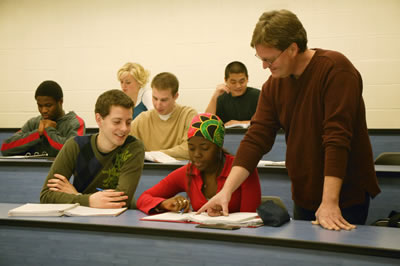|
Kentucky Autism Training Center
University of Louisville Autism Center
Kosair Charities Center
1405 E. Burnett Ave.
Louisville, KY 40217
katc@louisville.edu
(502)852-4631
|
|
|  |
2012 Autism Institute June 18, 19 and 20
Putting the Pieces Together through Collaboration: Bridges to a Brighter Future
University of Louisville Shelby Campus
Louisville, KY
Register Early and Save Early Bird Registration ends March 31st |
|
Upcoming Trainings
Webinars
3/1/2012
Using Visual Supports to Help Individuals on the Autism Spectrum
3/13/2012
Let's Walk Through the IEP
3/27/2012
Great Expectations! Building Better Communication Between Schools and Families
***************************
Supporting Autism 24/7
3/5/2012
Kentucky Dam State Park
3/23/2012
Barren River State Park
4/2/2012
General Butler State Park
4/23/2012
Greenbo State Park
5/11/2012
Rough River State Park
********************
| |
Poll
Please answer the short poll questions and let us know if you would you like to learn more about Evidenced Based Practices?  |
|
|
|
Featured KATC Resource Library Book |
Preparing For Life
by
Dr. Jed Baker
Publisher: Future Horizons, 2006
A comprehensive resource for students on the autism spectrum preparing for life after high school. The book offers "life skills training" on subjects such as non-verbal cues, body language, dealing with anger, frustration and anxiety, as well as building and maintaining friendships, roommates, and intimate relationships. Jed Baker focuses on conversational and employment skills, ways to balance work/school with family demands, and problematic areas such as finances, emergencies and transportation matters. The assessment tools he provides for parents and the analysis of the laws that provide accommodations to adults with disabilities are critical for success in life after high school. Learn more about how to request this book or other books in the KATC Resource Library. |
|
|
ASK KATC
| 
| |
Autism and Puberty KATC Family Field Trainer Jennifer Bobo, LCSW answers this common question.
Help! I think my son is hitting puberty. What do I do?
Answer:
Great question, as we know puberty is going to happen whether we are ready for it or not! Here are few things you can do.
Normalize the changes for our son or daughter. Let them know that everybody changes; their body will be changing on the inside and outside. Make sure to explicitly explain changes that occur and explain that these changes will happen specifically to your child. Also let your child know that puberty happens at different times for different children; your child's body may change at a different time from the other kids at school.
Prepare yourself for the discussion. Puberty is often an uncomfortable topic for parents, make sure you do your homework to increase your comfort with the topic. Discuss your thoughts with a significant other to work through your own feelings before addressing these topics with your child. Think about teaching skills related to puberty, like any other life skill that you will teach your son or daughter.
Make sure you consider your child's level of development and use age appropriate materials. Some questions to ask yourself to get prepared are: How comfortable are you talking about these issues with your child? Also how prepared are you to talk with your child about these issues? What is the goal of your discussion?
Talk early and often! Use accurate terminology to identify body parts. Break down conversations into manageable time frames. Discuss hygiene: when, why and how. Be clear, concise, concrete and explicit.
Tools to use at home? Visual supports are great to use at home when talking about puberty. (Check out the "Visual Supports" article in this newsletter) Social narratives also work well in explaining puberty to your child. Modeling is another effective teaching strategy for individuals with ASD.
More resources: KY PLANS
Do you have a question to ask the KATC Field Trainers? Send your question to katc@louisville.edu. The question and answer could be featured in our next newsletter.
Diandre Glover Thomas
Insight on Autism, Editor
|
|
|
When we think of a new year we often think about a fresh start and getting things off on the right track. In this newsletter w  e discuss ways to find life balance, visual supports, communication strategies between parents and educators, supporting individuals on the spectrum and many other resources to help you get a fresh start. In addition, we have many training opportunities available including webinars, regional workshops and the 2012 Autism Institute. Registration is available online now for all of these training opportunities. We hope these resources and training opportunities can help you get your year off on the right track. |
|
Finding Life Balance for You and Your Family
| |
by Jennifer Bobo
 In such a busy world it is so easy to find ourselves overextended and off balance. To start the New Year off right, we hope to help you find balance for yourself and your family. Finding good balance in life can lessen stress while improving your mental and physical health. Where can you begin? Take a minute to reflect on the quality of your life by identifying different areas within your life. For a great example check out this Wheel of Life to help identify these areas. In such a busy world it is so easy to find ourselves overextended and off balance. To start the New Year off right, we hope to help you find balance for yourself and your family. Finding good balance in life can lessen stress while improving your mental and physical health. Where can you begin? Take a minute to reflect on the quality of your life by identifying different areas within your life. For a great example check out this Wheel of Life to help identify these areas.
Are there specific areas that have been ignored and pushed to the side? What roles do you play on a daily basis? Are there some areas or roles within your life that gets too much attention? Not enough attention? Are you ever able to find time for yourself? What are your priorities in life? Does the way you spend your time reflect these priorities?
There are many different dynamics related to wellness and balance: quality relationships, maintaining physical health by eating well and exercising regularly, finding time for relaxation and knowing how to unwind, spirituality/faith, having a purpose, family life, and financial balance...just to name a few! I'm sure you could add to this list and hope you are able to take some time to identify the important dynamics in your life and work to find the right balance for yourself and family.
For more specific suggestions and resources to help find more balance in your life please review these KY PLANS resources. They identify great organizational tools, books from our resource library, family roles, tip sheets and more. Additionally check out our great information about visual schedules below, these can be a great resource at home with your children.
|
|
Supporting Parents of Young Adults with ASD
|  by Brian Freedman by Brian Freedman
Parents of children with ASD exhibit more significant stress and have greater challenges with coping than many other parents. But the period of transition to young adulthood can be particularly challenging, as families face changes to educational and service systems, as well as changes to their decision-making roles.
As people with ASD grow into young adults, they are expected to become stronger self-advocates and decision-makers in different areas of their lives, e.g., employment, independent living, and use of services. This important shift lays the groundwork for developing greater independence as an adult. Simultaneously, the parent's role as the main decision maker changes, which can be quite stressful and challenging, as many parents have served as the main advocate for their child throughout their life. Parents also have understandable fears about their child having increased exposure to others who might mistreat or take advantage of them, and they worry that their child may not be ready or capable of making well-informed decisions. Unfortunately, many parents also rarely receive any guidance or instruction on how to help their young adult become more independent and adjust to their own new role. Therefore, parents may benefit from support from their young adult's treatment team or other health/support provider. Here are some suggestions:
- Reflect empathy, not judgment, if a parent communicates resentment and fear of their changing role.
- Recognize the parent's value in remaining a critical member of the team and offer specific strategies on how they can support their young adult achieve greater independence.
- Offer to support the parent and young adult in developing a communication system that will help ensure that the parent receives important information from their young adult.
- Help parents reflect on advances their child has made in order to help them reframe their role and view it more positively.
Additional resources for the transition process and parental support:
|
|
Working Together to Support Individuals on the Spectrum
| by Rob Pennington
 Last week while working on a Fall cleaning project I stumbled upon an old plastic tub that had been "archived" in the basement. Amongst many other forgotten treasures, I found a dusty old pack of cigarettes. Those cigarettes belonged to my dear friend Mike who had stored his things in my house while searching for a place to live. Last week while working on a Fall cleaning project I stumbled upon an old plastic tub that had been "archived" in the basement. Amongst many other forgotten treasures, I found a dusty old pack of cigarettes. Those cigarettes belonged to my dear friend Mike who had stored his things in my house while searching for a place to live.
Mike was a semi-pro wrestler, a roadie for the rock band KISS, a truck driver, and a fanatical martial artist. He was a grizzly-sized man that never forgot birthdays, loved small children and animals, and sang out loud to Journey's "Separate Ways". Our paths crossed when I was asked by my martial arts instructor to do private lessons with "this guy who was obsessed with Bruce Lee". I was assured it would only be for a couple of weeks but this was the beginning of a nearly 10-year friendship. Mike and I developed a unique relationship. We met every Sunday to practice Kung Fu but we also spent much of our time talking through the kinks that life seemed to throw Mike's way. Mike would ask advice on a broad range of issues and seemed to need help understanding how others perceived the world and his actions therein. Mike's simple questions often cut right to the true nature of persons. So much,that I soon found myself offering pieces of my own life to be viewed through his lens. Mike and I worked through many tribulations in our years as friends. We talked almost daily and he became a constant in my families' life.
Mike's weakness in perspective taking led him down many exciting and rewarding roads like meeting and subsequently becoming a member of the road crew for KISS, wrestling Andre the Giant, and joining our martial arts school. Unfortunately, they also led him down many dark roads. Mike often found himself living with others that took advantage of him. As a result of one of his relationships, he lost his job, found himself living among drug users and became a victim of verbal and physical abuse. With community support, the help of friends and his own perseverance, Mike found a new place to live. Several people in the community stepped outside of their traditional roles and responsibilities to help him become more self determined. We helped Mike access traditional services through a diagnosis of Asperger syndrome. However, friends, family, therapists and his landlord all contributed to the construction of his new life. Mike found joy in designing his new apartment, selecting his own food and getting to know the people in his community. Mike passed away from natural causes about a year after living in his own place. In one of our last conversations, Mike mused upon how he had shown people that had doubted him that he could live on his own. We held a service for him in which a packed room shared with each other how he had touched their lives.
That pack of cigarettes sits in my office and reminds me of how much Mike enriched my life. It also prompts me to reflect on the powerful role that communities can play in the success of all individuals.
|
|
Very Special Arts (VSA) Kentucky
| |
 The Kentucky Autism Training Center currently has the beautiful artwork of VSA Kentucky's visual artists' Art on Tour traveling exhibit on display in the University of Louisville Autism Center. The exhibition is a selection of artwork from students with disabilities from across the state called A Matter of Perspective which was made possible by a partnership with the Kentucky Department of Education, Division of Learning Services. The Kentucky Autism Training Center currently has the beautiful artwork of VSA Kentucky's visual artists' Art on Tour traveling exhibit on display in the University of Louisville Autism Center. The exhibition is a selection of artwork from students with disabilities from across the state called A Matter of Perspective which was made possible by a partnership with the Kentucky Department of Education, Division of Learning Services.
Very Special Arts (VSA) Kentucky is a unique arts and disability organization that serves the entire state, is affiliated with the Kennedy Center for the Performing Arts and belongs to a national network of other arts and disability organizations. It provides arts education and inclusion programs for children and adults with disabilities throughout the state and offers underserved populations equal opportunities to explore the arts in a way that is fully accessible. The arts play a valuable and irreplaceable role in learning. VSA Kentucky works to advance the value of the arts in classrooms, communities and society in many ways.
Recognizing the artistic achievements of young artists with disabilities is an important part of VSA Kentucky's mission. Thousands of students are served each year through programs like the Arts Inclusion program, Student Traveling Exhibition, Side by Side, the Artist Roster, Arts in Healthcare and the Arts ACCESS Gallery online. Young artists are given opportunities to shine through their creative work. Programs encourage the involvement of parents, volunteers, teachers, artists, healthcare specialists and others as an important part of all programs.
VSA Kentucky programs offer students a means of self-expression, build self-confidence and help develop career skills  while fostering communication and independence. Art enhances education, advances socialization and promotes inclusion making it possible for more people with disabilities to contribute to the social, cultural and economic life of their communities. Research shows that a complete arts education program including dance, music and drama contributes to improved academic performance - particularly for students with disabilities. while fostering communication and independence. Art enhances education, advances socialization and promotes inclusion making it possible for more people with disabilities to contribute to the social, cultural and economic life of their communities. Research shows that a complete arts education program including dance, music and drama contributes to improved academic performance - particularly for students with disabilities.
 VSA Kentucky exists to serve all Kentucky communities by offering opportunities in each congressional district of the state. VSA Kentucky provides Professional Development opportunities for teachers, emerging and teaching artists through Start with the Arts, the Artist Registry, the Ron Billings Emerging Artist Award, the Young Soloist Award and other calls for art. VSA Kentucky's artists and programs bring ideas and questions about disabilities to the attention of others by creating a forum for discussion using diverse forms of expression. The artists' participation serves as an agent for social change by breaking down social barriers and promoting inclusion in the life of the community. To learn more about the organization and programs visit VSA Kentucky. VSA Kentucky exists to serve all Kentucky communities by offering opportunities in each congressional district of the state. VSA Kentucky provides Professional Development opportunities for teachers, emerging and teaching artists through Start with the Arts, the Artist Registry, the Ron Billings Emerging Artist Award, the Young Soloist Award and other calls for art. VSA Kentucky's artists and programs bring ideas and questions about disabilities to the attention of others by creating a forum for discussion using diverse forms of expression. The artists' participation serves as an agent for social change by breaking down social barriers and promoting inclusion in the life of the community. To learn more about the organization and programs visit VSA Kentucky.
|
|
Meet KATC's New Interns | |
by Ben Helm and Aaron Scott
 | | Ben and Aaron |
Aaron Scott and Ben Helm are KATC's newest interns and will be providing administrative support and assisting on special projects.
Aaron graduated from Sullivan University with an Associate's degree in Information Technology. Aaron's hobby is playing video games, his favorite restaurant is Buckhead's Mountain Grill and his most memorable vacation was when he went to Disney World. This is Aaron's first employed job, but he has worked very hard over the years cutting grass and house sitting for his family. Aaron's goals for this internship include "getting good work experience and interacting well with others."
Ben's hobby is playing the guitar and his favorite band is the Rolling Stones. Ben enjoy's watching Conan and The Daily Show with Jon Stewart on tv and he is a big fan of the Louisville Cardinals and the Indiana Hoosiers. Ben has volunteered at the Louisville Zoo's Herp Aquarium, worked at Ramsi's Café and Cave Hill Cemetery. Ben's work goals are to "make a difference for people on the autism spectrum and to work well with others."
We are happy to have Aaron and Ben here at the KATC and look forward to working with both of them. |
|
Beyond the Daily Notebook: Creative Home-School Communication
| by Julie Stewart
 Creating clear, effective communication among educational team members and specifically between teachers and families is a critical component to creating a successful educational experience for a student with disabilities. Students with an Autism Spectrum Disorder may or may not be able to independently communicate experiences from their school day. Here are some strategies for creatively communicating between home and school: Creating clear, effective communication among educational team members and specifically between teachers and families is a critical component to creating a successful educational experience for a student with disabilities. Students with an Autism Spectrum Disorder may or may not be able to independently communicate experiences from their school day. Here are some strategies for creatively communicating between home and school:
- FIRST Survey families regarding use of technology, schedules/availability and preferred modes and times for contact
- Conduct home visits throughout the year (if possible)
- Making sure to make "good news calls", phone calls for positive school experiences and not just to report negative information
- Daily 1-min voicemail message for parents/students to call at the end of each day
- Videos as visual report cards, especially for students with more complex challenges
- Program switch with daily report, step-by-step for responding to multiple questions when communicating with a family member, Ex. "What did you do today?","What did you have for lunch?",
- Offer families the opportunity to observe the classroom in the classroom or via technology (both actively and recorded)
- Create an "All About Me" notebook for each family to share about their student to be shared in the classroom and school
School and home are the two settings that impact a student's life experience the most and to create a good system of communicating both on a daily basis and throughout the year will develop a positive experience for everyone. Think outside the box and you will come up with some other strategies that will work for your educational teams!
|
|
Keeping your Eye on the Prize in the New Year
| |
by Rob Pennington
 As parents and educators forge into the New Year, it is important to review the educational efforts of the previous year. A month into the New Year is a perfect time for pouring over graphed data and making decisions about future instructional practices. It allows sufficient time to address changes in behavior as a result of the holiday break, but also provides an opportunity to change or adjust instructional programs/targets before potentially moving forward with ineffective strategies. A comparison of pre and post break data also may be useful in the determination of whether extended-school year services might be necessary for student success. As parents and educators forge into the New Year, it is important to review the educational efforts of the previous year. A month into the New Year is a perfect time for pouring over graphed data and making decisions about future instructional practices. It allows sufficient time to address changes in behavior as a result of the holiday break, but also provides an opportunity to change or adjust instructional programs/targets before potentially moving forward with ineffective strategies. A comparison of pre and post break data also may be useful in the determination of whether extended-school year services might be necessary for student success.
As a general rule, parents and professionals should review student progress every couple of weeks and make changes based on progress data. Progress on student goals may be slow but should be continuous. In other words, if a student has made no progress towards an objective within several weeks, then it is time for the teacher to make a change. Changes often involve adjusting reinforcement, modifying prompting strategies or antecedents, or reducing the complexity of the instructional objective. It is important to note that teachers may not discover the best method on the first try, but they must always be vigilant in not proceeding with ineffective instruction.
|
|
Using Visual Supports
| |
by Heidi Cooley-Cook

Most of us rely heavily on visual supports- our planner, traffic signs, placards indicating gender for the restroom and colored lines on the road just to name a few. It is easy to forget how beneficial visual supports are because we use them so often without even 'thinking about it'. The use of visual supports is an evidence-based practice for individuals with autism. There is a lot of research indicating that it is a very useful strategy for relaying information to individuals with autism. Simply put, visual supports translate auditory information into visuals. They can be used in a variety of settings, to provide choices, assist with transitions, provide information about upcoming activities and events, and can help break down complex tasks. It is important to remember that although visual supports are beneficial for most individuals, the support needs to me tailored to the individual. Supports can be in the form of tangible objects, real-life photos, picture symbols/line drawings, and written words, as well as combination of these modes. The key is to keep information simple and concise (ex. 2-3 word phrase vs. sentence).
Here are a few examples of where visual supports may be beneficial:
- washing hands
- getting ready for bed
- going to the grocery store
- visiting family/friends
- meeting new people
It's crucial to modify the level of information given, such that your child/student is successful and slowly fade out supports if necessary. Don't forget that we all rely on visual supports so it is not necessary that the schedule go away completely!
|
|
Online Resources for Work and Home
| by Laura Ferguson
 Whether you are a teacher, parent, therapist, or researcher in the field of autism, you always are seeking out helpful web sites. When working in this field you are always attempting to make sure you are keeping up with the most up to date research, taking efficient data, and learning new techniques. Often, time is the issue. We need a location that provides all this information. It needs to be easy to access and understand.
When researching such websites, I came across Polyxo.com. The web site was easily accessible and had many relevant up to date resources I often use in my work. I was able to search through teaching strategies, could join a discussion list, look through curricula and access resources. One of the most beneficial parts of the website was the ability print out data collection materials.
As parents and professionals, we often take a lot of time attempting to construct these data collection systems, but this websites allows us to save that much needed time. I enjoyed browsing this site and will definitely use it in the future. I hope that you will browse through the site and find it useful as well.
|
|

The mission of the Kentucky Autism Training Center is to strengthen our state's systems of support for persons affected by autism by bridging research to practice and by providing training and resources to families and professionals. KATC is committed to improving the quality of life for those affected by ASD.
|
|
|